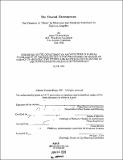The enacted environment--the creation of "place" by Mexicans and Mexican Americans in East Los Angeles
Author(s)
Rojas, James Thomas
DownloadFull printable version (13.79Mb)
Alternative title
Creation of "place" by Mexicans and Mexican Americans in East Los Angeles
Advisor
Sandra C. Howell.
Terms of use
Metadata
Show full item recordAbstract
In this thesis I will examine how residents of East Los Angeles use their front yards and streets to create a sense of "place." The environment created in this way I call "enacted." People are both users and creators of a place and thus become "texture" in the urban landscape. People activate environments merely by their presence. People enact place because of use and social interactions, contrary to the belief of architects that peoples' lives neatly revolve around functions of physical form. There are many different approaches to understanding physical environments and social characteristics of people, but very few deal with "enacted environments." The sociologist examines peoples' behavior. The urban planner analyzes numbers. The anthropologist examines artifacts while movie directors and writers recreate the "feeling" of a place by combining peoples' lives with the physical form. All are excellent in understanding a specific dimension of a place. However, in comprehending the complexities of the enacted environment one needs to rely on all these disciplines. Those who "enacted" in East Los Angeles are Mexican and Mexican American. By the year 2010 it is estimated that the Latino population will be 40% of the total population of Southern California. By understanding the transformations of the physical form and social relations in Latino neighborhoods, I can develop a framework of what is taking place so that this thesis can serve as an aid to better understand the "Mexicanization" of space in the suburbs of Los Angeles, but this methodology can also be used in understanding other "enacted environments" in the urban landscape.
Description
Thesis (M.S.)--Massachusetts Institute of Technology, Dept. of Architecture, 1991. Includes bibliographical references (leaves 93-95).
Date issued
1991Department
Massachusetts Institute of Technology. Department of ArchitecturePublisher
Massachusetts Institute of Technology
Keywords
Architecture